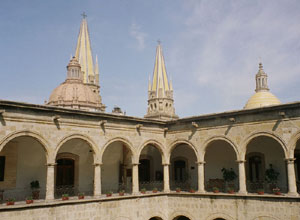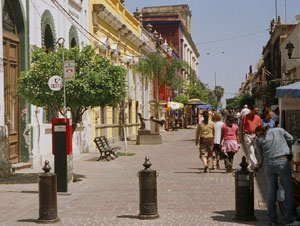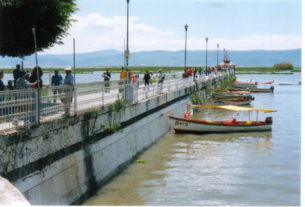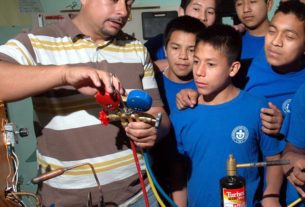Guadalajara is the second largest city in Mexico. The metropolitan area includes Tlaquepaque, Tonala, and Zapopan, with a total population of about 4 million people. It is located about 200 miles east of Puerto Vallarta, and 300 miles west of Mexico City. Guadalajara seems prosperous, orderly, and clean, compared to most Mexican cities.
My wife and I enjoyed a March 2007 trip to Guadalajara, during which I collected the information for this article.
A walking tour of Guadalajara museums
A logical starting place for a walking tour of Guadalajara is the the Palacio del Gobierno, near the Cathedral. While it is a working government office, it contains two impressive murals by Orozco. One mural is on and above the stairway, and features Father Hidalgo looming over a scene of revolutionary struggle. The other mural is in the old legislature hall, depicting Father Hidalgo, Benito Juarez, and the freeing of the slaves. The murals are very bold, violent, and dark, perhaps reflecting the time, when the world was hurtling toward World War II.
While you are in the area, stop into the Cathedral, with its twin towers, which were rebuilt after the 1818 earthquake. Consider lunch or a snack at Sandy’s restaurant, on the second floor, on the north side of the Rotonda de los Jaliscienses Ilustres, which honors some of Jalisco’s important personages. The Rotonda is just north of the Cathedral, and is also where one can catch a double decker bus tour of the city.
 The Museo Regional de Guadalajara is just to the east of the Rotunda. The first floor includes a woolly mammoth skeleton, lots of huge bones, pre-hispanic ceramics, as well as some obsidian and metal. We were particularly impressed with the ceramics and the obsidian knives. Upstairs you will find sacred art, as well as halls relating to the history of the state of Jalisco, which was previously known as Nueva Galicia. I came away with the impression that Jalisco has been a conservative area for at least 200 years, and that it was less affected than other areas of the country by most of the conflicts that occurred between 1810 and 1930. I was slightly disappointed by the museum, as some had said that it was a must-see. The signage is all in Spanish, but look for laminated cards with information in English. This museum is open 9 a.m. to 5:45 p.m., Tuesday to Saturday, Sunday 9 to 4:30, closed Monday.
The Museo Regional de Guadalajara is just to the east of the Rotunda. The first floor includes a woolly mammoth skeleton, lots of huge bones, pre-hispanic ceramics, as well as some obsidian and metal. We were particularly impressed with the ceramics and the obsidian knives. Upstairs you will find sacred art, as well as halls relating to the history of the state of Jalisco, which was previously known as Nueva Galicia. I came away with the impression that Jalisco has been a conservative area for at least 200 years, and that it was less affected than other areas of the country by most of the conflicts that occurred between 1810 and 1930. I was slightly disappointed by the museum, as some had said that it was a must-see. The signage is all in Spanish, but look for laminated cards with information in English. This museum is open 9 a.m. to 5:45 p.m., Tuesday to Saturday, Sunday 9 to 4:30, closed Monday.
From the Museo Regional, walk east across the huge Plaza de la Liberacion, and continue on through the Plaza Tapatia. You will be walking by the tourist office on the left, and will see a huge multi-story jewelry mall on your right. The jewelry mall is worth walking through; we have never seen such a large number of jewelers under one roof. It seemed that every possible style of jewelry was represented there. Continue east to the entrance to the Instituto Cultural Cabañas, a former orphanage.
The Hospicio Cabañas was founded by the bishop of Guadalajara for the sick and orphaned. The complex was named for Bishop Cabañas, who was most instrumental in the design and construction. Construction was started in 1791. This complex of buildings was used as an orphanage as late as 1980, when it became the Instituto Cultural Cabañas. Today, the children are housed in a modern building near Plaza del Sol.
The buildings are impressive in themselves, and the complex is little changed from its original design. Because of the significance and preservation of the buildings and murals, the Hospicio was designated a World Heritage Site by the United Nations in 1997. The site is perhaps best known for the Orozco mural, the Man of Fire, completed in 1939. This is a series of murals covering the walls and ceiling of the main chapel, and is often regarded as his masterpiece. A tour of the murals is included in the admission, and tours are available in English and Spanish. We took the tour in Spanish, but between poor acoustics, the lofty language used to explain the significance of the murals, and the rapid speech of the guide, the tour was very difficult to follow. Wait for the tour in English, and stand close to the guide. There is a very good bookstore at the entrance; most of the books are in Spanish. Some of the buildings are used as galleries for changeable exhibits, and there is even a theater to show films. Walk through some of the tranquil courtyards, with sculptures and beautiful landscaping. The range of things to see is remarkable; allow adequate time, perhaps a couple of hours.
If you only go to one museum in Guadalajara, I recommend this one. It is open Tuesday to Saturday, 10 to 6, and Sunday 10 to 3, closed Monday.
And since you are in the neighborhood, take a look at the Mercado Libertad, just south of the Hospicio Cabañas. It is the largest covered market in Latin America. It is interesting just to walk through, even if you don’t intend to buy. We were pleasantly surprised to find the vendors in the mercado to be helpful rather than aggressive; this was our experience throughout the trip, not just at the Mercado Libertad.
Other Guadalajara museums:
The Casa de las Artesanías de Jalisco is not really a museum, since almost everything is for sale.
But the quality of the handicrafts is excellent, representing everything from furniture to blown glass. If you see an artisan that you like, the attendants can provide you with the contact information, allowing you to visit their studio, or perhaps order off of their web site. If you are interested in shopping for handicrafts, this is the place to start. Even if you do not buy there, you will be able to view quality work, and know what it is worth. A must-see for shoppers. The museum is located near the Parque Agua Azul, south of the center of Guadalajara. It is open from 10 a.m. to 6 p.m., Monday to Friday, 10 to 5 on Saturday, and 10 to 3 on Sunday.
The Museo de Arte Huichol is an interesting museum, dealing with the crafts, lives, religion, myths, and clothing of the Huichol Indians. The Huichol are well known for their brightly colored paintings and handicrafts. Most of their work uses geometric designs, made using beads or threads held in place by beeswax. I particularly liked their story of a great flood, in which the survivor is told to take with him five kernals of every color of corn, rather than animals, to repopulate the world. Corn is extremely important in the culture and diet of Mexicans, as evidenced by that story. This museum is open 10 to 6, seven days a week, and includes a shop. It is located next to the Basilica de Zapopan, where believers come from far and wide. You can reach Zapopan on the air-conditioned turquoise “TUR” buses, which pass just south and west of the center of town. The “TUR” buses also go to Tlaquepaque and Tonalá.
The Museo de Arte de Zapopan (MAZ) is located on the same plaza as the Basilica, and is open 10 to 6 from Tuesday to Sunday.
The Museo de Arte de la Universidad de Guadalajara has exhibits that change every three months. Admission is free, and it is open from 10 to 6 Tuesday to Friday, 10 to 4 on Saturday and Sunday. This is located west of the city center.
The Ex-Convento de Carmen has exhibits that change every month. It is open 10 AM to 8 PM, Tuesday to Sunday. This is located several blocks west of the center of town, on Madero.
The Museo de la Ciudad is focused on Guadalajara history. It is located on Calle Independencia, a few blocks west of the Rotonda de los Jaliscienses Ilustres. The museum is open from 10 a.m. to 5:30 p.m. Tuesday to Saturday, 10 to 2:30 on Sunday, closed Monday.
The Globo Museo del Niño is for kids. It is located a few blocks east of the Parque Agua Azul, on calle 5 de febrero. The museum is open 9:30 a.m. to 7:30 p.m., Tuesday to Friday, 10 to 6 Saturday and Sunday, closed Monday.
The Museo de Paleontologia houses an impressive collection of fossils. It is located in the Parque Azul, and is open from 10 to 6 Tuesday to Saturday, 11 to 6 on Sunday, closed Monday.
Tlaquepaque
Central Tlaquepaque has a pedestrian street at the center of town, Independencia street. Most of the town’s attractions can be found on or near the pedestrian area. The pedestrian area is pleasantly quiet, clean, and orderly.
The turquoise TUR bus will take you there from Guadalajara in about 30 minutes for 9 pesos, less than $1 US.

The Museo Regional de Ceramica is located on the west end of Independencia. The work is excellent and varied. We particularly liked the miniatures. Most of the work is very traditional, and much of it is more than 50 years old. The museum is free, and open from 10 to 6, closed Mondays.
The Centro Cultural El Refugio is on Calle Priscilano Sanchez, three and a half blocks north of the pedestrian street, Independencia. It contains many of the winners of the ceramic competition. This competition is held each year in June, and has been going on since 1977. Each artisan is trying to outdo the others, and the results can be amazing. I remember a miniature bullring, about two inches in diameter, with people in the stands! Aside from the technical feats, much of the work is quite beautiful.
The work here is the best of the best, and well worth the short walk.The museum is free, and open from 10 to 6, closed Mondays.
Many of the galleries of Tlaquepaque can be considered museums in their own right. The overall quality was impressive, but don’t expect their crafts to be inexpensive. Most of the galleries sell handcrafted products from various regions of Mexico. A few artists have their own galleries, including Sergio Bustamante. The Bustamante gallery was very much like a museum, containing art in several mediums, including many bronze sculptures.
While you are in Tlaquepaque, we highly recommend the Casa Fuerte restaurant, famous for the Torta de Elote, an excellent cornbread with interesting sauce. For entertainment, we suggest El Parian — eighteen restaurants and bars around a central courtyard. This is located on the pedestrian street, Independencia, just east of the churches. We were fortunate enough to be there during a mariachi show on the central bandstand or kiosco. There were a dozen musicians playing horns and guitars, and three different lead singers during the show. But even if there is not a “show”, there will be mariachis strolling around, looking for someone to buy a song or two. Just be sure to ask the cost of a song before you start.
General tips
Most museums are closed on Mondays. The entrance fees are very modest, generally ten pesos (one dollar US) or less.
Be sure to pick up a map of the city, free at the tourist office, or included in most guidebooks. I purchased a “Blue Map”, a tourist map of Guadalajara, which included a map of the state of Jalisco, a map of the Guadalajara region, a map showing the streets in most of Guadalajara, which had very small print, as well as a subway map, a detailed map of the historic center, and a small map of Chapala. I felt that the Blue Map was worth the $5 US it cost; however, no single map is perfect for every use, and I generally refer to two or more maps in the course of a day.
The Friday issue of the newspaper Público has a section called “Ocio,” which has very extensive information about movies, music, entertainment and cultural events in and around Guadalajara, including a section on “Artes Plásticas”, the visual arts. This may help you identify special museum exhibits that you would want to see, or other events. Music is a pretty safe bet, something that anyone can appreciate, whether they speak Spanish or not. We enjoyed a performance of the Jalisco Philharmonic, featuring the women of the Jalisco Chorus.
Enjoy your visit to Guadalajara.
Richard Ferguson
March 17, 2007


